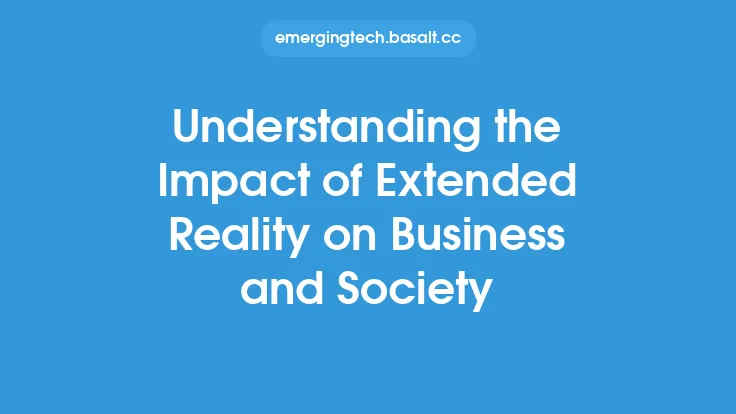Extended Reality (XR) is a term used to describe a range of technologies that extend human experience beyond the physical world. It encompasses Virtual Reality (VR), Augmented Reality (AR), and Mixed Reality (MR), which are often referred to collectively as XR. These technologies have been rapidly advancing in recent years, and their impact on the tech landscape is significant.
Introduction to Extended Reality Technologies
Extended Reality technologies are designed to create immersive and interactive experiences that simulate or enhance the real world. Virtual Reality (VR) creates a completely artificial environment, shutting out the physical world and immersing the user in a virtual one. Augmented Reality (AR) overlays digital information onto the real world, enhancing it with virtual objects, sounds, or other sensory inputs. Mixed Reality (MR) combines elements of both VR and AR, allowing users to interact with virtual objects in the real world.
Key Components of Extended Reality
Several key components are necessary for Extended Reality to function. These include a device to display the virtual environment, such as a headset or smartphone; sensors to track the user's movements and position; and software to render the virtual environment and interact with the user. The device can be a dedicated XR headset, a smartphone, or even a computer. Sensors such as accelerometers, gyroscopes, and cameras are used to track the user's movements and position, allowing the virtual environment to respond accordingly.
Applications of Extended Reality
Extended Reality has a wide range of applications across various industries. In entertainment, XR is used to create immersive gaming experiences, virtual concerts, and interactive movies. In education, XR is used to create interactive and engaging learning experiences, such as virtual labs and field trips. In healthcare, XR is used for therapy, treatment, and training, such as exposure therapy for anxiety disorders and surgical training simulations. In retail, XR is used to create immersive shopping experiences, such as virtual try-on and product demonstrations.
Technical Requirements for Extended Reality
Extended Reality requires significant technical capabilities to function smoothly. These include high-resolution displays, powerful processors, and advanced sensors. The device must be able to render high-quality graphics in real-time, track the user's movements accurately, and respond quickly to user input. Additionally, XR devices often require significant storage and memory to handle complex virtual environments and large amounts of data.
Challenges and Limitations of Extended Reality
Despite its many benefits, Extended Reality also faces several challenges and limitations. One of the main challenges is the cost of XR devices, which can be prohibitively expensive for many consumers. Another challenge is the limited content available for XR, which can make it difficult for users to find engaging and interactive experiences. Additionally, XR devices can be bulky and uncomfortable to wear, which can limit their use for extended periods.
Future Developments in Extended Reality
The future of Extended Reality is exciting and rapidly evolving. Advances in technology are expected to make XR devices more affordable, accessible, and user-friendly. The development of new XR applications and experiences is also expected to drive growth and adoption. Additionally, the integration of XR with other technologies, such as artificial intelligence and the Internet of Things, is expected to create new and innovative use cases for XR.
Impact of Extended Reality on Society
The impact of Extended Reality on society is significant and far-reaching. XR has the potential to revolutionize the way we interact, work, and play. It can create new opportunities for education, training, and entertainment, and can also improve our daily lives in many ways. For example, XR can be used to enhance our commute, make shopping more engaging, and even improve our mental and physical health. However, XR also raises important questions about the impact of technology on our society and our humanity, and it is essential to consider these implications as XR continues to evolve and grow.
Conclusion
In conclusion, Extended Reality is a rapidly evolving field that has the potential to transform the tech landscape in many ways. Its applications are diverse and widespread, and its impact on society is significant. As XR continues to advance and improve, we can expect to see new and innovative use cases emerge, and its adoption to become more widespread. Whether you are a developer, a consumer, or simply someone interested in the latest technologies, Extended Reality is definitely worth paying attention to.





